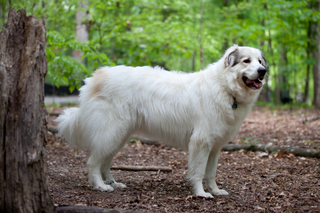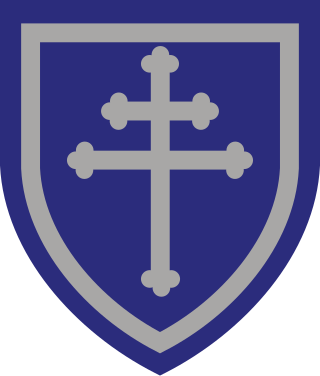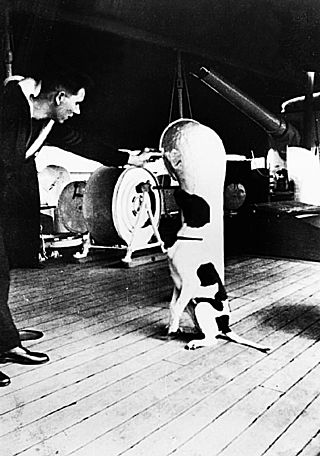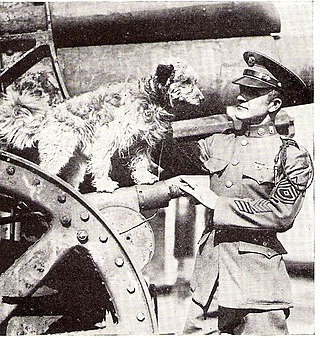
Cher Ami was a male homing pigeon known for his military service during World War I, especially the Meuse-Argonne offensive in October 1918. He is famous for delivering a message alerting American forces to the location of the Lost Battalion, despite sustaining severe injuries.

The Pyrenean Mountain Dog or Chien de Montagne des Pyrénées is a French breed of livestock guardian dog; in France it is commonly called the Patou. It originates from the eastern or French side of the Pyrenees Mountains that separate France and Spain and is recognised as a separate breed from the Mastín del Pirineo or Pyrenean Mastiff from the Spanish side of the mountains, to which it is closely related.

The Meuse–Argonne offensive was a major part of the final Allied offensive of World War I that stretched along the entire Western Front. It was fought from September 26, 1918, until the Armistice of November 11, 1918, a total of 47 days. The Meuse–Argonne offensive was the largest in United States military history, involving 1.2 million French, Siamese, and American soldiers, sailors and marines. It is also the deadliest campaign in the history of the United States Army, resulting in over 350,000 casualties, including 28,000 German lives, 26,277 American lives and an unknown number of French lives. American losses were worsened by the inexperience of many of the troops, the tactics used during the early phases of the operation, and the widespread onset of the global influenza outbreak called the "Spanish flu."

The 79th Infantry Division was an infantry formation of the United States Army Reserve in World Wars I and II.

The 119th Field Artillery Regiment, nicknamed the "Red Lions", is a Parent Field Artillery Regiment of the United States Army Regimental System (USARS) in the Michigan Army National Guard. The headquarters of the 119th Field Artillery Regiment is in Lansing, Michigan, and its principal training ground is at Camp Grayling, Michigan, the largest National Guard training center in the country. The Headquarters Battery of the current 119th Field Artillery Regiment can trace its history back to the First Battle of Bull Run in 1861, during the American Civil War. The history of the 119th Field Artillery Regiment as an entire regiment began on 6 November 1911 when it was organized as the 1st Battalion, Field Artillery in the Michigan National Guard.

Dogs have a very long history in warfare, starting in ancient times. From being trained in combat, to their use as the scouts, sentries, messengers, mercy dogs, and trackers, their uses have been varied and some continue to exist in modern military usage.

Sergeant Stubby was a dog and the unofficial mascot of the 102nd Infantry Regiment and was assigned to the 26th (Yankee) Division in World War I. He served for 18 months and participated in 17 battles and four offensives on the Western Front. He saved his regiment from surprise mustard gas attacks, found and comforted the wounded, and allegedly once caught a German soldier by the seat of his pants, holding him there until American soldiers found him. His actions were well-documented in contemporary American newspapers.

Judy was a ship's dog aboard HMS Gnat and Grasshopper stationed on the Yangtze before and during World War II. She proved able to hear incoming aircraft, providing the crew with an early warning. After part of the crew transferred from Gnat to Grasshopper in June 1939 the ship was sent to Singapore after the British declaration of war on Germany. There she was aboard the ship during the Battle of Singapore, in which Grasshopper evacuated for the Dutch East Indies. It was sunk en route and Judy was nearly killed, having been trapped by a falling row of lockers. She was rescued when a crewman returned to the stricken vessel looking for supplies.

Bamse was a St. Bernard dog that became the heroic mascot of the Free Norwegian Forces during the Second World War. He became a symbol of Norwegian freedom during the war.
Shoulder sleeve insignia (SSI) are cloth emblems worn on the shoulders of US Army uniforms to identify the primary headquarters to which a soldier is assigned. The SSI of some army divisions have become known in popular culture.

The 157th Infantry Brigade is an active/reserve component (AC/RC) unit based at Camp Atterbury, Indiana. The unit is responsible for training selected United States Army Reserve and National Guard units. The unit was activated using the assets of the 5th Brigade, 87th Division. The brigade is a subordinate unit of First Army Division East.

The 132nd Infantry Regiment was an infantry regiment of the United States Army, part of the Illinois Army National Guard.
The 314th Infantry Regiment is an infantry regiment of the U.S. Army first organized in 1917.

Rags was a mixed breed terrier who became the U.S. 1st Infantry Division's dog-mascot in World War I.
Nantillois is a commune in the Meuse department in Grand Est in north-eastern France. Nantillois is situated on the D15 between Montfaucon and Romagne-sous-Montfaucon.
The 113th Field Artillery Regiment is a field artillery regiment of the United States Army National Guard.

A free-ranging dog is a dog that is not confined to a yard or house. Free-ranging dogs include street dogs, village dogs, stray dogs, feral dogs, etc., and may be owned or unowned. The global dog population is estimated to be 900 million, of which around 20% are regarded as owned pets and therefore restrained.
Tich (1940–1959) was a military dog during the Second World War. She was awarded the Dickin Medal in 1949 for her actions during the war as a battalion mascot to the King's Royal Rifle Corps. After the war she lived with her battalion handler at his home in the UK. When she died she was buried in the People's Dispensary for Sick Animals (PDSA)'s Ilford Animal Cemetery.

William Jones Nicholson was a career officer in the United States Army. He attained the rank of brigadier general during World War I as commander of the 157th Infantry Brigade, a unit of the 79th Division. He was most notable for leading his brigade to victory during the September 1918 Battle of Montfaucon, part of the first phase of the Meuse-Argonne Offensive, for which he received the Distinguished Service Cross.














